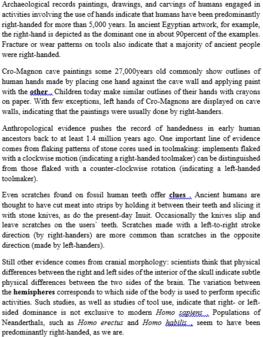Read the following passage and mart the letter A, B, C or D on your answer sheet to indicate the correct answer to each of the questions from 35 to 39.
Fish that live on the sea bottom benefit by being flat and hugging the contours. There are two very different types of flatfish and they have evolved in very separate ways. The skates and rays, relatives of the sharks have become flat in what might be called the obvious way. Their bodies have grown out sideways to form great “wings” They look as though they have been flattened but have remained symmetrical and “the right way up”. Conversely fish such as plaice, sole, and halibut have become flat in a different way. There are bony fish which have a marked tendency to be flattened in a vertical direction; they are much “taller” than they are wide. They use their whole vertically flattened bodies as swimming surfaces, which undulate through the water as they move. Therefore when their ancestors migrated to the seabed, they lay on one side than on their bellies. However, this raises the problem that one eye was always looking down into the sand and was effectively useless - In evolution this problem was solved by the lower eye “moving” around the other side. We see this process of moving around enacted in the development of every young bony flatfish. It starts life swimming near the surface, and is symmetrical and vertically flattened, but then the skull starts to grow in a strange asymmetrical twisted fashion, so that one eye for instance the left, moves over the top of the head upwards, an old Picasso - like vision. Incidentally, some species of 20 flatfish settle on the right side, others on the left, and others on either side.
The word “this” refer to _______.
A. the migration of the ancestors
B. the difficulty of the only one eye being useful
C. the problem of the one eye looking downwards
D. the practice of lying on one side




Kiến thức: Đọc hiểu
Giải thích:
Từ "this" dùng để chỉ _______.
A. sự di cư của tổ tiên B. sự khó khăn của việc chỉ một mắt có ích
C. vấn đề của việc một mắt nhìn xuống D. việc chỉ nằm về một phía
Thông tin: Therefore when their ancestors migrated to the seabed, they lay on one side than on their bellies. However, this raises the problem that one eye was always looking down into the sand and was effectively useless.
Tạm dịch: Vì thế, khi tổ tiên của chúng di cư xuống đáy biển, chúng đã nằm một bên chứ không phải trên bụng. Tuy nhiên, điều này làm nảy sinh vấn đề mà một mắt nhìn xuống cát và kết quả là khá vô ích.
Chọn D